Chapter: 11th Computer Technology : Chapter 14 : Computer Network
Wired Technologies and its types
Wired
Technologies
The
means through which data is transferred from one place to another is called
transmission or communication media. There are two categories of transmission
media used in computer communications.
•
Wired/Bounded/Guided media
•
Wireless/Unbounded/Unguided media
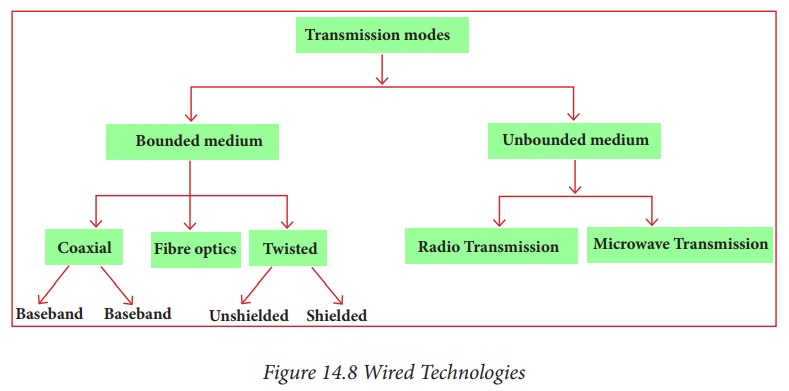
Bounded/Guided Media
There
are three common types of bounded media in the data transmission. They are
•
Twisted-Pair Cable,
•
Coaxial Cable, and
•
Fibre-Optic Cable.
Twisted-pair
and coaxial cable use metallic (copper) conductors that accept and transport
signals in the form of electric current. Optical fibre is a cable that accepts
and transports signals in the form of light.
Twisted Pair Cable
A
twisted pair consists of two conductors (normally copper), each with its own
plastic insulation, twisted together. One of these wires is used to carry
signals to the receiver, and the other is used only as ground reference. In
addition to the signal sent by the sender on one of the wires, interference
(noise) and crosstalk may affect both wires and create unwanted signals.
Twisted Pair is of two types:
•
Unshielded Twisted Pair (UTP)
•
Shielded Twisted Pair (STP)
Unshielded Twisted Pair Cable
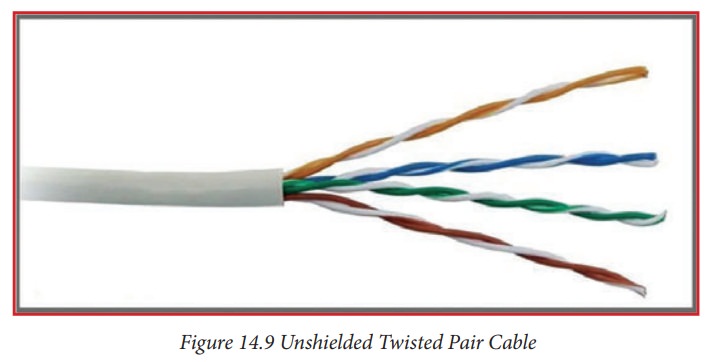
It
consists of two insulating copper wires (1mm thick). The wires are twisted
together in a helical form to reduce electrical interference from similar pair.
Identification is the reason behind coloured plastic insulation.
Advantages
•
It has high speed capacity.
•
Higher grades of UTP are used in LAN technologies like Ethernet.
Disadvantages
•
Bandwidth is low when compared with Coaxial Cable.
•
Provides less protection from interference.
Shielded Twisted Pair Cable
This
cable has a metal foil or braided-mesh. Electromagnetic noise penetration is
prevented by metal casing. Shielding also eliminates crosstalk. It is faster
than unshielded and coaxial cable.
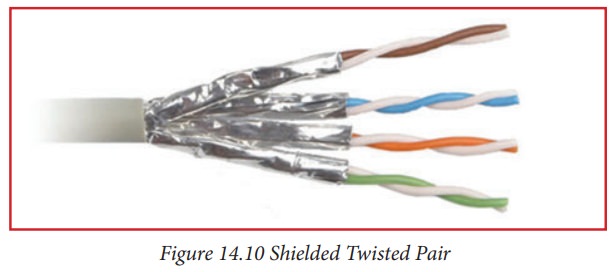
![]()
![]()
Advantages
•
It can be used for Analog or Digital transmission
•
It increases the signalling rate.
•
It eliminates crosstalk.
Disadvantages
•
It is difficult to manufacture
Coaxial Cable
•
Coaxial is called by this name because it contains two conductors that are
parallel to each other.
•
Copper is used in this as a central conductor. It is surrounded by PVC
installation.
•
Outer metallic wrapping is used as a shield against noise and as a second
conductor which completes the circuit.
•
The outer conductor is also encased in an insulating sheath. The outermost part
is the plastic cover which protects the whole cable.
•
The the most common coaxial standards are:
![]()
![]()
![]() • 50-Ohm RG-7 or RG-11 : used with thick Ethernet.
• 50-Ohm RG-7 or RG-11 : used with thick Ethernet.
•
50-Ohm RG-58 : used with thin Ethernet
•
75-Ohm RG-59 : used with cable television
•
93-Ohm RG-62 :
used with ARCNET .
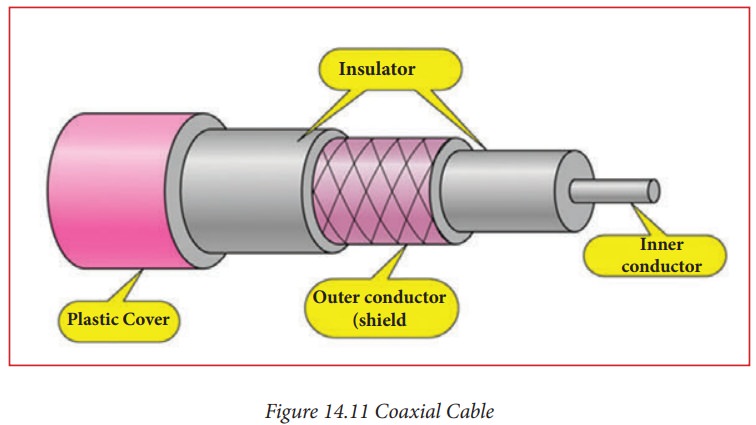
Advantages
•
It is used in long distance telephone lines.
•
It transmits digital signals at a very high rate of 10Mbps.
•![]()
![]()
![]()
![]()
![]() It has higher noise immunity.
It has higher noise immunity.
•
It transmits data without distortion.
•
The can span to longer distance at higher speeds as they have better shielding
when compared to twisted pair cable
Disadvantages
•
Single cable failure can fail the entire network.
•
If the shield is imperfect, it can lead to grounded loop.
Fiber Optical Cable
A fibre-optical cable is made of glass or plastic and transmits signals in the form of light. In fibre optical cable, light moves only in one direction. For two way communication to take place a second communication must be made between the two devices. Optical fibres use reflection to guide light through a channel. A glass or plastic core is surrounded by a cladding of less dense glass or plastic. The difference in density of the two materials must be such that a beam of light moving through the core is reflected off the cladding instead of being refracted into it.

Fibre-Optic Cable Connectors
There
are three types of connectors for fibre-optic cables, as shown in the figure
below.
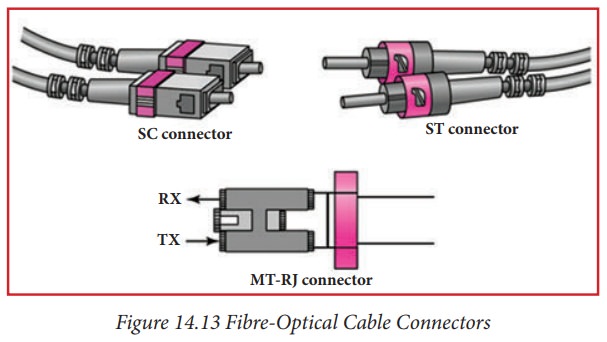
The
Subscriber Channel (SC) connector is used for cable TV. It uses push/pull
locking system. The Straight-Tip (ST) connector is used for connecting cable to
the networking devices. The MT-RJ connector utilizes two fibres and integrates
them into a single design that looks similar to an RJ45 modular connector.
Advantages
Fibre
optic has several advantages over metallic cable:
•
It is resistant to corrosion.
•
It shows greater immunity to tapping.
Disadvantages
•
It has unidirectional light propagation.
Related Topics